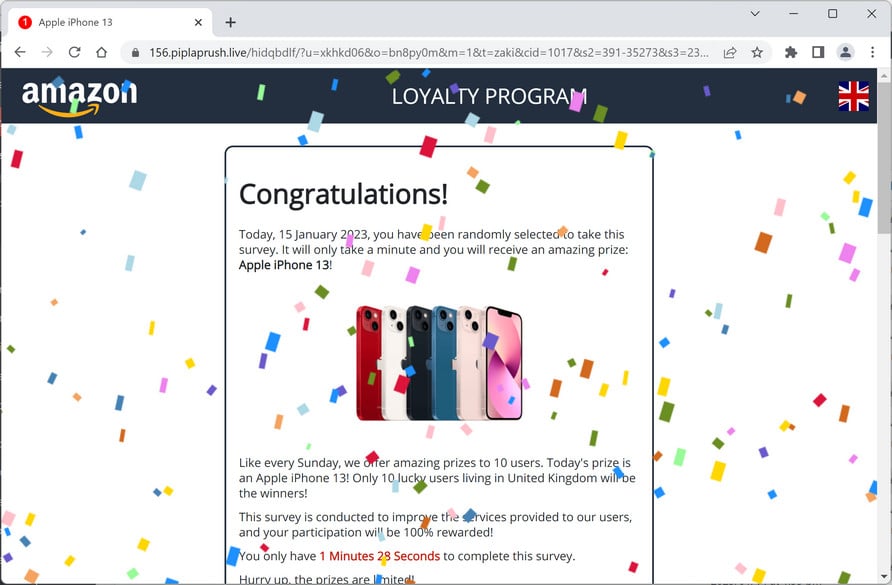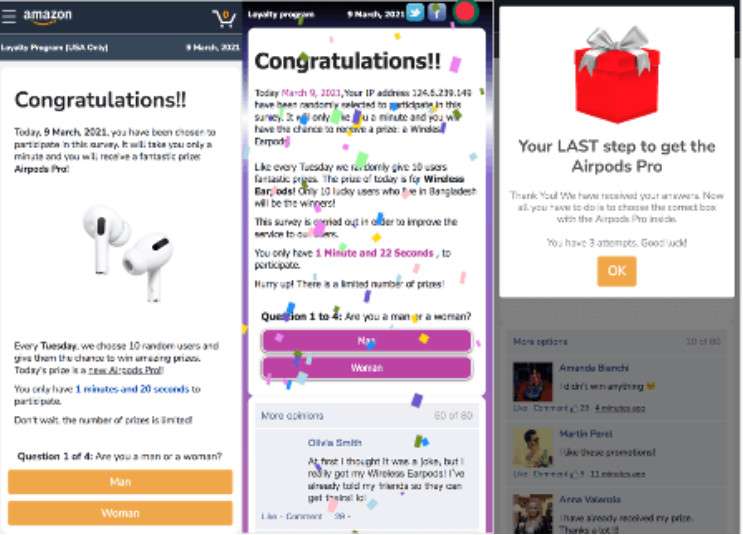The excitement of Valentine’s Day has scammers promoting a fake “Amazon Valentine’s Method” to try and fool shoppers into thinking they can earn $750 Amazon gift cards. Scam websites and social media ads claim users can generate gift card codes through a special promotion “trick” by following simple steps. But in reality, this ploy is an elaborate affiliate marketing scheme aiming to profit off your personal data, not reward you.
This comprehensive guide will uncover how this seasonal scam really works so you can avoid manipulation.

Understanding the Deceptive Premise Behind This Scam
The excitement and increased shopping around Valentine’s Day provides the perfect opportunity for scammers to capitalize. Fraudulent websites, social media ads, and Youtube videos are promoting a phony “Amazon Valentine’s Method” offering $750 gift card codes to unsuspecting shoppers.
At first glance, the scam appears completely legitimate. The sites use Amazon’s official branding including logos, fonts, and imagery. Headlines entice users by claiming “Unlimited $750 Amazon Gift Cards with our Valentine’s Method!” or “Score $750 in Free Amazon Gift Cards for Valentine’s Day Gifts!”.

To take advantage of the purported deal, users are instructed to click call-to-action buttons and follow simple steps. These might include taking online surveys, signing up for site memberships or subscriptions, downloading mobile apps, or providing personal information.
The pages employing this scam exploit the urgency around preparing for Valentine’s Day. Language warns to “Act Fast Before This Exclusive Promotion Ends!” and “Hurry, this Valentine’s Method expires soon!”. Countdown timers create false scarcity.
In reality, these websites have absolutely no affiliation with Amazon itself. The too-good-to-be-true offers of easy free gift cards are complete fabrications, strategically employing the Valentine’s Day theme to drive traffic and bait victims.
After users complete the initial steps, no gift card is provided. Instead, more requirements are endlessly presented, leading to a cycle of unnecessary surveys and downloads that only benefit the scammers. The sites earn affiliate commissions and harvest user data while nothing is ever awarded to victims.
Let’s break down exactly how this seasonal social scam unfolds.
How the Fake Amazon Valentine’s Method Scam Works
While formats vary, here are the standard steps users are led through with this ruse:
1. You Encounter a Website, Ad or Video Promoting the Scam
While browsing social media or shopping online, an ad grabs your attention with mentions of a special “Amazon Valentine’s Method” for a $750 gift card.
Urgency language pressures you to act fast before the deal expires to capitalize on this seasonal promotion.
2. You Click Their Link to Redeem Your Gift Card
Eager to score what seems like easy free Amazon money for Valentine’s Day gifts, you click the link provided.
You are taken to a convincing phishing site made to look exactly like Amazon’s real website.
3. You Are Instructed To Complete Specific Steps to Get the Card
The page claims that by following their “Valentine’s Method” steps, you can generate a $750 Amazon code.
Instructions typically include taking surveys, downloading apps, or signing up for service trials.
4. You Provide Personal Information to Complete These Steps
To complete the required steps, you have to provide a range of personal information. This includes your Amazon login, phone number, address, and even credit card details.
5. You Keep Trying More Steps, But Never Get a Gift Card Code
Despite completing the initial steps, no gift card code is provided. You are instructed to finish more and more tasks, surveys, and offers to finally unlock it.
This cycle repeats as you waste time on pointless steps while your personal data is harvested.
6. Scammers Disappear Once They Have Your Information
Eventually it becomes clear no $750 Amazon gift card exists. The “Valentine’s Method” was a total scam.
Meanwhile, scammers have disappeared after collecting your data and earning affiliate commissions from your activity.
Recognizing the Warning Signs of This Seasonal Amazon Scam
While this Valentine’s offer seems highly enticing, several key details reveal it’s a fraudulent ploy:
- Unsolicited Deals Requiring Urgent Action – Legitimate rewards never pressure urgency or demand upfront activity.
- Too-Good-To-Be-True Rewards – $750 Amazon cards are highly improbable for simple steps.
- Misspelled or Suspicious URLs – Inspect site URLs for subtle differences indicating phishing.
- Personal Information Requests – Amazon never requests this data for gift cards.
- Redirects Elsewhere – Being sent to outside sites is a major red flag.
- Endless Extra Steps – Repeatedly requiring more tasks before rewards is deceptive.
Staying alert to these signs helps spot and shut down seasonal scams trying to exploit Amazon’s reputation.
What to Do If You’re Already a Victim of This Scam
If you engaged with a website or ad touting the fake Amazon Valentine’s Method, take these actions right away:
- Contact Amazon – Notify them of the phishing scheme misusing their brand.
- Monitor Accounts Closely – Watch for any unauthorized charges or activity.
- Change Passwords – Update any passwords entered on scam pages. Enable two-factor authentication.
- Scan Devices for Malware – Run complete scans to check for and remove spyware or viruses.
- Cancel Services – Unsubscribe from any trial offers or services signed up for.
- Warn Others – Share your experience to prevent others from falling victim too.
Remaining vigilant against unbelievable free offers and verifying legitimacy is critical to avoid seasonal scams.
Frequently Asked Questions About the Fake Amazon Valentine’s Method Scam
1. What is the Amazon Valentine’s Method scam?
This seasonal scam promotes a fake “Valentine’s Method” to earn a $750 Amazon gift card. Scam ads and websites pressure urgency around Valentine’s Day.
2. How does the Valentine’s Method scam work?
Users are redirected to fake Amazon pages claiming you must take surveys or complete offers to generate a gift card code through the Valentine’s Method. No rewards are ever given.
3. What types of steps do the scam pages require?
Typical required steps include:
– Personal surveys
– App downloads
– Subscription or trial sign-ups
– Providing account logins
4. What are signs it’s a scam, not a real promotion?
Warning signs include:
– High-pressure tactics with fake urgency
– Too-good-to-be-true rewards
– Spelling errors and odd URLs
– Requests for sensitive personal information
– Redirects to outside affiliate offer sites
5. What should I do if I already provided information?
Contact Amazon immediately about the phishing page. Monitor accounts closely for fraudulent charges. Change any compromised passwords. Run malware scans.
6. How can I avoid Valentine’s shopping scams in the future?
Verify promotions through Amazon’s official website only. Never provide personal information or downloads to third parties. Use discretion around holiday-themed offers.
7. Who creates these fake Amazon Valentine’s offers?
Affiliate marketers use trending holidays like Valentine’s Day to create believable phishing scams and profit off of user data.
8. How can I spot and report Valentine’s shopping scams?
Look for urgent language, fake sites, and too-good-to-be-true rewards. Report scam ads to platforms. Share warnings about confirmed phishing schemes.
9. Are there other versions of this gift card scam for different holidays?
Yes, variations exist themed around holidays like Christmas, New Year’s and Mother’s Day. Always verify Amazon offers through official channels.
10. What is the best way to avoid Amazon phishing scams?
Use unique passwords, never click unverified links, enable two-factor authentication, and always confirm promotions on Amazon.com before providing information.
The Bottom Line on the Fake Amazon Valentine’s Method
In summary, websites promoting an Amazon “Valentine’s Method” for $750 gift cards are fraudulent affiliate marketing schemes, not actual promotions. By revealing their deceptive techniques, consumers can recognize phishing attempts aiming to score off the Amazon name.
Approach unbelievable deals requiring upfront information or downloads with skepticism, especially around major holidays. Verify legitimacy through official Amazon channels before providing data. Don’t let dreams of free Valentine’s Day gifts open the door to scams. Empower yourself to spot and shut down phony offers capitalizing on seasonal marketing trends.










